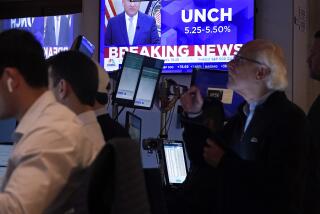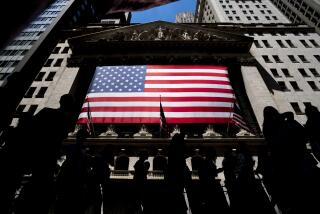Stocks End on Buying Spree; Dow Jumps 14
NEW YORK — The stock market closed with a rush of buying Thursday to post its second straight gain.
Airline and computer stocks turned in standout performances in a fairly active session.
The Dow Jones average of 30 industrials jumped 14.34 to 1,541.63, bringing its gain for the past two sessions to 22.59 points.
Volume on the New York Stock Exchange reached 130.46 million shares, against 122.42 million on Wednesday.
Credit Markets Mixed
Analysts said some pleasant surprises among the first of the current crop of quarterly earnings reports had perked up investors’ spirits.
They also said the market, and transportation stocks in particular, benefited from notable price declines in petroleum futures markets.
The latest gains came without much support from the credit markets, where prices and interest rates were mixed. Views of the interest-rate outlook have been changing rapidly and often in the past several days.
First, signs of a strengthening economy chilled hopes for a cut in the Federal Reserve’s discount rate. Then, optimism about the chances for lower interest rates revived amid talk that the United States would propose this weekend that the so-called Group of Five nations make a coordinated effort to bring rates down.
But, on Thursday, some investors apparently concluded that that speculation was unfounded.
The pessimists on rates believe that the Fed is reluctant to promote easier credit now, with the pace of business activity evidently picking up.
The Fed reported Thursday morning that industrial production increased 0.7% last month, on top of an upward-revised gain of 0.6% in November.
Computer Stocks Gain
Computer stocks were strong for the second straight day. Digital Equipment, which reported better-than-expected quarterly earnings Wednesday, climbed 4 5/8 to 146.
International Business Machines, which is expected to issue an upbeat earnings report today, rose 3 3/8 to 156.
Among the airlines, which would stand to benefit from lower fuel prices, AMR picked up 2 3/4 to 44 5/8, UAL 3 1/8 to 52 and Delta 2 1/4 to 41 3/4.
In the energy sector, by contrast, Exxon dropped 1 1/8 to 52 3/4, Amoco 1 1/8 to 61 1/2, Chevron 3/4 to 35 1/2 and Mobil 1/2 to 30 3/4.
ASA gained 1 to 40 3/8 and Homestake Mining 3/4 to 26 7/8 in the precious-metals group. The price of gold reached an 18-month high in world markets Thursday, rising $7.50 an ounce to $356.60 on the Commodity Exchange in New York.
Rumors of a possible takeover or leveraged buy-out boosted the price of Federated Department Stores stock 3 to 69 1/4 in heavy trading. Officials at the company declined to comment on the rumors.
Revived interest in secondary stocks helped carry the NASDAQ composite index for the over-the-counter market up 1.82 to a new closing high of 330.01, surpassing the previous peak reached Jan. 7.
In the overall tally on the Big Board, advances outnumbered declines by nearly three to two. The exchange’s composite index added 0.50 to 120.62.
Large blocks of 10,000 or more shares traded on the NYSE totaled 2,425, compared to 2,557 on Wednesday.
Nationwide turnover in NYSE-listed issues, including trades in those stocks on regional exchanges and in the over-the-counter market, totaled 155.62 million shares.
The Wilshire index of 5,000 equities closed at 2,155.627, up 9.731.
Standard & Poor’s index of 400 industrials rose 0.92 to 231.89, and S&P;’s 500-stock composite index was up 0.91 at 209.17.
At the American Stock Exchange, the market value index closed at 248.24, up 1.05.
30-Year Treasury Bond Up
Government bond prices finished with gains and interest rates declined responding to unexpectedly favorable monetary figures.
The benchmark 30-year Treasury bond, which dropped in morning trading, rose 3/4 point, or about $7.50 for each $1,000 in face value. The yield on the key Treasury bond stood at 9.49%, compared to 9.42% late Wednesday.
Yields on short-term Treasury securities tumbled.
The three-month bill fell 13 basis points to 7.03%, the six-month bill dropped 11 basis points to 7.16% and the one-year bill was down 13 basis points to 7.21%. A basis point is one-hundredth of a percentage point.
The core figures in the Federal Reserve Board’s weekly money supply report were not all that well received. The M1 money measure rose $3.9 billion in the week ended Jan. 6.
The increase exceeded many expectations and depressed some bonds.
But the attention of government securities traders was soon captured by Fed data that they deemed more positive. The report showed that banks needed to borrow an unusually low amount from the Fed in order to satisfy reserve requirements, indicating that the banking system is more flush with funds than previously believed.
In the secondary market for Treasury securities, prices of short-term governments rose from 3/16 point to 1/4 point. Intermediate maturities moved up from 1/2 point to nearly a full point and the 20-year bond rose 21/32 point, according to the investment firm of Salomon Bros. The movement of a point is equivalent to a change of $10 in the price of a bond with a $1,000 face value.
Indexes Mixed
The Merrill Lynch daily Treasury index, which measures price movements on all outstanding Treasury issues with maturities of a year or longer, dipped 0.07 from late Wednesday to 109.87. The Shearson Lehman daily Treasury bond index, which makes a similar measurement, closed up 1.68 to 1,155.88.
In corporate trading, industrials and utilities dropped 3/8 point in light dealings.
Among tax-exempt municipal bonds, revenue bonds rose 1/4 point and general obligations were unchanged. Trading was light.
The federal funds rate--the interest on overnight loans between banks--traded at 7.875%, down from 8.5% late Wednesday.
More to Read
Inside the business of entertainment
The Wide Shot brings you news, analysis and insights on everything from streaming wars to production — and what it all means for the future.
You may occasionally receive promotional content from the Los Angeles Times.










